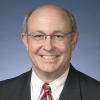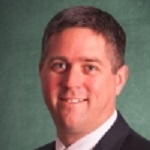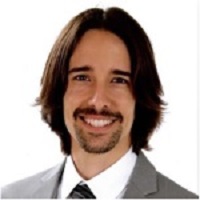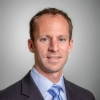In February 2017, Duane Miller, PE, from the Lincoln Electric Company, presented Welding Myths that Structural Engineers Need to Know About. He nominated The City Mission in Cleveland (https://www.thecitymission.org) for the SEU Speaker Inspires donation of the month.
Duane shared why he chose The City Mission: “An icon in the welding world, Mr. Omer W. Blodgett passed away in January 2017 at the age of 99. In his honor, his family has requested donations be made to the Cleveland City Mission, an organization that has for over a century provided help and hope to Cleveland’s hurting and homeless; in his honor, I’d like this SEU donation to be made. Mr. Blodgett’s was a longtime supporter of not only the Cleveland City Mission, but of similar organizations in other major cities throughout the US. To me, Mr. Blodgett was my mentor. In an unselfish way, he wanted me to “take over his work” and he showed me how to do so. I’ll never replace him—no one will—but he taught me how to continue to do what he did. He was an exceptional engineer, a tremendous teacher and an consistent Christian, leaving a legacy and an example for all of us to model.”
Thank you, Duane, for helping structural engineers with your SE University session, and for your designation of The City Mission in Cleveland as our SEU Speaker Inspires Organization of the Month!
SE University began the SEU Speaker Inspires program in 2015 as a way to “pay it forward”, enabling our speakers to designate a charity/organization of their choice for SE University to make a donation to help improve our world.
In January 2017, Matthew Rechtien, PE, Esq., a member of the law firm of Bodman PLC, presented A Case Study, and Legal Perspectives, on Engineering Ethics: The Kansas City Hyatt. He nominated the David and Maxine Fowler Endowed Excellence Fund at the University of Texas at Austin(http://endowments.giving.utexas.edu/page/fowler-david-maxine-exc-fnd-caee/4886/) for the SEU Speaker Inspires donation of the month.
Matthew shared why he chose the David and Maxine Fowler Endowed Excellence Fund: “Dr. Fowler, with the support of his wife, Maxine, has been a mentor, advocate, and friend for twenty years. As a professor at the University of Texas for half a century, he has touched the lives of literally hundreds of other engineering students, engineers and others in a similar way. Dr. Fowler is a gentleman and scholar in every sense of those words. I am humbled to be able to contribute, in any way (but especially by, as he did, teaching my fellow engineers), to his legacy, including the David and Maxine Fowler Endowed Excellence Fund.”
Thank you, Matthew, for helping structural engineers with your SE University session, and for your designation of the David and Maxine Fowler Endowed Excellence Fund as our SEU Speaker Inspires Organization of the Month!
SE University began the SEU Speaker Inspires program in 2015 as a way to “pay it forward”, enabling our speakers to designate a charity/organization of their choice for SE University to make a donation to help improve our world.
27 Jan 2017
Desk Organization for Maximum Productivity
Take a look at your desk…. Is it helping or hindering your ability to have the most productive day possible? Do you waste time searching for those submittals from last week that the contractor is asking about on the phone, as you are frantically searching under shop drawings and through piles of mail? Basic organization at work is essential to maximum productivity. At times, even the most Type A person can get a bit disorderly throughout the day, but following these 5 tips can help you get organized and stay organized, so that your productivity can remain top notch throughout the week:
- Start with a deep clean. Take everything off of your desktop area and start fresh. Clean, dust and sanitize your work environment. Then, design a quick setup of your computer and most used office supplies, so that you have them at your fingertips throughout the day. Separate all paperwork into 3 piles: trash, items that need to be filed, and items that require action.
- Create a box system that works for you. You may only need an incoming and outgoing mail box, or you may need additional box trays for items on hold, a designated area for shop drawings, or current project files that need to be within reach. Set up specific areas for each type of incoming paper, and keep up with proper redistribution of these materials as they come into your office. Filter all of the paperwork you removed from your desk into these new designated box trays or areas.
- Minimize personal items in your office, especially items that occupy valuable desk space. Consider moving pictures to hang on the wall rather than sit on your desk, and eliminate any items that have collected dust, as they clearly are not everyday essentials.
- Keep current projects in a separate file drawer close to your desk and archive projects that are complete. Keep large scale drawings rolled and standing vertically in a box, if possible, to free up desk space.
- Schedule time each week to maintain organization. The time it takes to keep organized is less than the time wasted from being unorganized! Before leaving for the day or weekend, be sure to clean up and distribute paperwork as needed, so you can start each day with a focus on maximum productivity.
04 Jan 2017
Specifications for Steel Castings
Have you been involved in a project with extensive architecturally-exposed steel connections or complex geometric constraints? Or, have you ever considered using standardized steel castings to improve seismic resistance in braced frame construction? Structural steel castings can be a benefit in all of these situations, but may not be as familiar to most engineers as traditional designs.
In the November 2016 SE University Supplemental Session, Carlos de Oliveira, M.A.Sc.,P.Eng., from Cast Connex Corporation, gave a talk on Structural Applications for Steel Castings. During this lunch and learn presentation, Carlos gave a brief history of the use of steel castings, explained how they are manufactured, and discussed when steel castings can be used to benefit the structural design. Both standardized and custom castings can be useful in solving complex structural geometry and connections, and are typically more aesthetically pleasing for the architect. Some of the structural designs shown in his presentation were truly impressive and may inspire some ingenuity in your next design.
Using steel castings may be new to some structural engineers, however, Carlos gave some tips on specifying castings in the contract documents. For custom castings, the engineer and architect need to provide the overall dimensions, configuration, and relationship to other structural and architectural components on the drawings. Then, the engineer should include additional requirements within the specification to delegate the structural design responsibility to the casting supplier by outlining the structural performance requirements (ie. structural loading, structural connection to the castings, and machining requirements), as well as architectural performance requirements (ie. surface finish, and AESS welding requirements).
Carlos also provided some resources for using templates for these specifications for custom and standardized steel castings. These templates are a great tool to get started in specifying structural steel castings for your next project that includes complex geometry or architecturally exposed steel. Click on the slide below to view an excerpt from the specs or click visit http://www.arcat.com/arcatcos/cos48/arc48577.html to view example specs and catalogs for various steel casting connections.
In December 2016, Kimberley Robinson, PE, SE, from SunSteel LLC, gave a talk on Structural Irregularities per the ASCE7-10 Seismic Design Requirements. She chose the Structural Engineers Association of Utah Scholarship Program (http://www.seau.org/) for the SEU Speaker Inspires donation of the month.
Kim shared why she chose the SEAU Scholarship Program: “I think that it is very important to support young and talented would-be engineers and bring them closer to their goal of a college degree and a rich and rewarding career.”
Thank you, Kim, for helping structural engineers with your SE University session, and for your designation of the SEAU Scholarship Program as our SEU Speaker Inspires Organization of the Month!
SE University began the SEU Speaker Inspires program in 2015 as a way to “pay it forward”, enabling our speakers to designate a charity/organization of their choice for SE University to make a donation to help improve our world.
In November 2016, Carlos de Oliveira, M.A.Sc., P.Eng., from Cast Connex Corporation, gave a talk on Structural Applications for Steel Castings. He chose the École Lakay Project in Haiti (http://www.cca-acc.com/cca/ecole-lakay/) for the SEU Speaker Inspires donation of the month.
Carlos chose the École Lakay Project because his company has previously donated to the design and re-construction of this project after the 2010 earthquake destroyed this trade school in Port-au-Prince. The new facility includes state-of-the-art seismic-resistant High Strength Connectors, made by Cast Connex, which have been fabricated and erected, but the project needs additional funding to complete the non-structural components of the building through Builders without Borders and the Canadian Construction Association. Besides teaching the students a trade, the school also provides basic necessities and will be able to accommodate 200 students upon completion.
Thank you, Carlos, for helping structural engineers with your SE University session, and for your designation of the École Lakay Project as our SEU Speaker Inspires Organization of the Month!
SE University began the SEU Speaker Inspires program in 2015 as a way to “pay it forward”, enabling our speakers to designate a charity/organization of their choice for SE University to make a donation to help improve our world.
28 Nov 2016
Utilizing Vacation = Increased Productivity
The average American employee leaves over 3 days of paid vacation unused, despite the evidence that spending time away from work is beneficial for both the employee and employer. Spending time away from work actually increases your productivity while at work. Research has shown this to be the case, and it makes logical sense. We tend to be more focused and driven to complete tasks in a timely manner when we know a vacation day is coming and we have less time to complete our workload. We spend less time socializing or wasting time on smart devices or social media, rather we work tirelessly to ensure we wrap things up before leaving on vacation. Research also shows spending time away from work decreases stress, improves health, boosts the office morale and creates a more loyal employee.
So why do workers continue to leave unused vacation on the table? Heavy workloads and often self imposed pressures to not take time off tend to be the biggest contributors. With the holiday season at our doorstep, may this serve as a good reminder of the benefits of using your vacation time with those that matter most. A healthy and well-rested employee is of greater value to their family and their employer. So, enjoy your time away and return with renewed energy and determination to be a benefit to your employer!
In November 2016, Scott Nacheman, MSc.Eng., AIA, from DeSimone Consulting Engineers, gave a talk on The Indiana State Fair Collapse Incident. He chose the United Service Organizations (http://www.uso.org/) for the SEU Speaker Inspires donation of the month.
Scott shared why he chose the USO: “I am involved with several organizations that support our men and women in uniform and feel that in today’s world of uncertainty the USO provides some much needed support and ‘gap filling’ for our nation’s protectors. The men and women of the United States Armed Forces have made significant sacrifices in order to protect our way of life domestically and abroad. The USO provides support and assistance to these brave individuals in order to make their deployments a little easier, and assists them in maintaining communication with loved ones back in the States.”
Thank you, Scott, for helping structural engineers with your SE University session, and for your designation of the United Service Organizations as our SEU Speaker Inspires Organization of the Month!
SE University began the SEU Speaker Inspires program in 2015 as a way to “pay it forward”, enabling our speakers to designate a charity/organization of their choice for SE University to make a donation to help improve our world.
28 Oct 2016
Purposeful Meetings
Do you often feel as though you spent half of your work day in a meeting, and have yet to get anything accomplished? Perhaps you are the one running the meetings and feel the participants lack enthusiasm or appear bored? Meetings can set the tone for your office environment, so why not strive for upbeat, purposeful, and productive meetings? Here are a few pointers to improve your participation and your ability to lead a productive meeting:
Tips for being an active participant:
- Be on time. Being late is both annoying to your peers and also requires items to be repeated, which leads to inefficiency.
- Be positive and look for the positive. In every meeting, there is at least some helpful piece of information that can you can use going forward.
- Participate. There is nothing worse than asking a group of people a question, and getting no response and blank stares. Be respectful of the presenter and give him/her the same courtesy that you would appreciate.
Tips for being an effective leader:
- Prepare well and delineate a clear purpose for the meeting. Try not to let the discussion get off-topic, or repetitive in nature. Aim to encourage the team with the purpose moving forward, with specific take-aways and goals for the immediate future.
- Be respectful of everyone’s time. Start on time, endeavor to end on time, and never fill the time just for the sake of it. Consider cancelling a meeting if there is no specific need for everyone to be gathered, or consider sending an email if the topics are only informational and do not require discussion.
- Be energetic and involve others. Meet with others ahead of time to encourage them to share their opinions, and set a positive and inclusive tone by asking questions of everyone.
Overall, meetings are a necessary part of our work culture, but they needn’t be tedious or negative. Make your next meeting a success by implementing one of these strategies, which can help others and improve your day too!
17 Oct 2016
SE Solutions Provides Scholarships to 3 MSCE Structures Students from Purdue University (2016)
SE Solutions was pleased to recently present scholarships to three Purdue University Structures students to help defray the cost of their education. Goran Milutinovic, Ryan Whelchel, and Alana Wilbee were the recipients of the awards. This is the fifth year that SE Solutions has offered the scholarships.
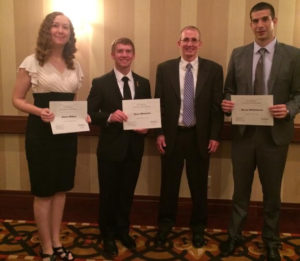
Purdue University MSCE Students and Scholarship Winners Alana Wilbee (left), Ryan Whelchel (middle), SE Solutions, LLC President, Brian Quinn, and Goran Milutinovic (right)
Goran Milutinovic received his BS in Civil Engineering from University of Belgrade in Serbia, Europe, and will complete his MSCE at Purdue in December 2016. His masters thesis was sponsored by INDOT and focused on the load rating of bridges and overweight vehicles. Goran became fascinated with long-span bridges as a child, which sparked his interest in structural engineering. Goran appreciates bridges, as he believes they represent intellectual effort as well as a connection to life and people that is depicted in his favorite novel, The Bridge on the Drina. After graduating, Goran will begin working with Janssen Spaans Engineering in Indianapolis. Goran is married and has a two year old daughter and is expecting another child very soon.
Ryan Whelchel received his BS in Architectural Engineering from Kansas State University. He is currently working on his MSCE at Purdue and plans to continue to pursue a PhD in Civil Engineering. Ryan is currently working as a graduate research assistant focusing on prestressed concrete bridges. Learning how buildings stand up and how to design structural systems has always been fascinating to Ryan, and upon graduating, he hopes to find work at a structural engineering firm where he can be challenged and create innovative structural solutions.
Alana Wilbee received her BS in Civil Engineering at Purdue in 2015. Following the completion of her MSCE at Purdue in December of 2016, she will begin working on her PhD research focusing on structural health monitoring techniques to support community-wide damage assessment in post-disaster scenarios. Alana is originally from Colorado Springs, and decided to pursue engineering when she realized the field would capitalize on her inclinations toward building and problem solving. After debating between aerospace and civil engineering, Alana decided that designing safe and beautiful places for people to live and work was more important to her than figuring out how to move people through the sky.
SE Solutions would like to congratulate each recipient and wish them future success in their fields of study as structural engineers.

